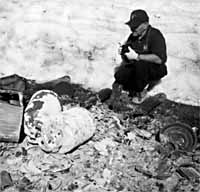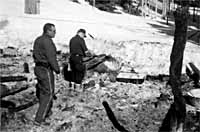Fire on the mountain
Arson exacerbates backcountry
use debate

"I think it’s a no-brainer that [the fire] is going to
exacerbate tension and create more concern. That’s sad. I don’t want to think
that way."
- Bob Jonas, co-owner of burned yurts.
By TRAVIS PURSER
Express Staff Writer
Name-calling and fist-shaking have been the comparatively mild
manifestations of the decades-old territorial conflict between snowmobilers and skiers in
the Wood River Valley north of Ketchum. Now, the burning of two Mongolian-style tents on
Sunday, April 2, threatens to ratchet up the tension between those with a need for speed
and those with a need for quiet.
 Investigators are unable to locate several missing
items from the burned yurts, owner Bob Jonas said, including six, one-gallon cans of camp
stove fuel and a cooler, “big enough to hold six cans.” Above, Sheriff’s
Sgt. Ron Taylor sifts through the remains of a yurt. (Courtesy photo)
Investigators are unable to locate several missing
items from the burned yurts, owner Bob Jonas said, including six, one-gallon cans of camp
stove fuel and a cooler, “big enough to hold six cans.” Above, Sheriff’s
Sgt. Ron Taylor sifts through the remains of a yurt. (Courtesy photo)
Compounding the issue, state and local investigators late last week
concluded the fire that destroyed the semi-permanent tents, called yurts, was the work of
one or more unknown arsonists.
At stake for both snowmobilers and skiers is the outcome of ongoing
mediated negotiations between the two groups to draw up a map that segregates the upper
Wood River Valley into motorized and non-motorized uses.
Without segregation, skiers fear they will eventually be driven out of the
area by ever-more-powerful snowmachines that roar across high alpine virgin slopes,
carving deep swaths that they say make skiing dangerous.
Bob Jonas and his partner Sarah Michael, proprietors of the Ketchum-based
Sun Valley Trekking Co., co-own the burned yurts and four other winter huts in the area.
During a tour of the burn site on Friday—located 10 miles north of Ketchum in the
Sawtooth National Recreation Area—the fit and wiry Jonas, 57, said he believes
snowmobilers and skiers have reached a point where negotiations have virtually stalemated.
With dramatically increasing numbers of backcountry skiers over the last
two decades, Jonas said, along with the invention of the "powder sled"
snowmachine in the mid-1990s, coexistence of the two uses in the same area is no longer
possible.
Before the mid-1990s, snowmobilers were largely limited to cruising the
valley floor due to their relatively underpowered machines that didn’t climb hills
well. The powder sled, however, with its light weight and powerful two-stroke engine,
encourages riders to explore high-alpine slopes, laying ever-higher tracks, called
"high lines."
High lines, skiers say, ruin their skiing.
Snowmobilers point to a 1970s informal agreement between the groups that
divides the valley in half—skiers north of Prairie Creek, snowmobilers south. The
encroachment of skiers, and their yurts, in the high alpine area south of Prairie Creek
since the early ‘90s was not an issue until the recent invention of the powder sled
that has allowed snowmobilers to reach those higher areas.
Reports of conflicts have discouraged customers from renting yurts, where
skiers traditionally spend the night after long, slow treks, Jonas said, while
snowmobilers vehemently refuse to relinquish territory to skiers.
Jonas said he has heard reports of snowmobilers yelling profanities at
skiers, and of skiers whacking snowmobilers with ski poles.
Jonas said "possibly" an irate snowmobiler set fire to his
$20,000 yurt encampment. "There’s always rednecks on both sides of the
fence," he said.
Of major concern to Jonas were 11 one-gallon cans of camp stove fuel
stored inside the yurts. Five of the cans were clearly visible in the charred wreckage,
while the other six cans were missing, he said.
Also missing was a cooler "big enough to hold six cans," Jonas
said, speculating that whoever set the fire might have carried away the evidence.
 Courtesy photo
Courtesy photo
Sergeant Ron Taylor of the Blaine County Sheriff’s Office, right, and Joe Griffin,
law enforcement officer for the Ketchum Ranger District, left, comb the wreckage on
Monday, April 3.
Two snowmobile tracks located about 60 feet south of the yurts also
concerned Jonas. It was unusual to see snowmobile tracks so close, he said, because of a
courtesy zone around the yurts inside of which the machines rarely go.
The arson, it seems, couldn’t come at a worse time. Last fall, SNRA
supervisor Bill LeVere, challenged the two user groups to map out segregated motorized and
non-motorized zones in the Wood River Valley by October 2001—otherwise, he said, he
would do it for them.
Since January, a map subcommittee of the Blaine County Recreation
District-organized Winter Coalition has been meeting almost every week to hammer out the
map.
The Winter Coalition is a group of snowmobilers and skiers that has met
regularly each winter since 1994 to work toward resolving their conflicts.
Similar efforts have been underway in the Stanley Basin area.
"I have lived in the Sawtooth Valley-Stanley Basin area for about 19
years now and am hopeful that we are once again making progress in getting some areas set
aside for cross-country skiers and snowmachiners," said Julie Meissner in a recent
letter to the Mountain Express.
If the Blaine County map committee can decide on a map, it will be the
first time in the upper Wood River Valley that skiers and snowmobilers have reached a
legally binding recreation zoning agreement in the area. Now, some say, that won’t
happen.
"I think it’s a no-brainer that [the fire] is going to
exacerbate tension and create more concern," Jonas said. "That’s sad. I
don’t want to think that way."
Andy Munter of Ketchum, one of five skiers on the map committee, said
during an interview Monday that relentless bickering within the group has prevented any
real work from being accomplished.
"We’re not even close," to drafting a map, he said. Then,
choosing his words carefully, he added the group has barely gotten past the handshaking
stage.
"We’ve been working hard to understand each other and understand
the issues," he said. "I don’t know what else I can say without getting
inflammatory."
In Munter’s view, there are three possible outcomes from the map
committee negotiations. Most unlikely, he said, the group will agree on a map in the
coming months. Or, he said, negotiations will continue fruitlessly until October, when
SNRA superviser LeVere will create his own map.
Most likely, however, the committee will decide that continuing to meet
creates more conflict than it resolves, Munter said.
"By prolonging meetings, are we getting closer to understanding each
other, or are we inflaming tempers?" he asked.
In the wake of the fire, angered skiers on the map committee were anxious
to talk to reporters. Snowmobilers, however, adhered to an informal agreement among Winter
Coalition members not to discuss controversial issues with the press.
During a Monday telephone call, Blaine County Recreation District trails
director, Shelly Preston, refused to give out any information on the 10 committee members,
including their names. As the map committee coordinator, Preston said she is the
"media spokesperson for snowmobilers."
"It’s kind of late notice for me," she said. "I’d
have to track them down to see if they’d be willing to talk. It’s not set up to
have instant access to them."
Map committee snowmobilers Nancy Munk, Chris Klick and Kim Nielsen did not
return a reporter’s phone calls. Map committee snowmobiler Bill Demun, reached by
telephone in Bellevue, declined to comment.
Preston said she was aware of the yurt fire, adding, "I think it
could be arson."
However, Preston insisted the fire would have no effect on the map
committee’s negotiations: "I have a lot of faith in this group and the process.
The process has been rolling along really well."
Preston said the group has a working copy of a map, but when asked if the
group had laid out zones yet, she said, "No. They’re starting to look at each
group’s priorities. They’re still learning to communicate with each other and
work through conflicts."
Whether the next meeting of the map committee has been scheduled is
unclear. Preston said she was unsure if it had been scheduled, while Demun said a meeting
has been scheduled for next week.
If the coalition does create a zoning map, LeVere will be able to enforce
the agreement through federal regulations. Those regulations would also allow LeVere to
create and enforce his own zoning if no agreement is reached. The process would be similar
to the one that closed the area around Galena Lodge to motorized use a few years ago.
Whatever the case, Jonas said he hopes the fire will promote greater
understanding between snowmobilers and skiers.
"Hey, we’re both out having fun," he said. "The powder
sledder—they love powder snow in their face, they love making tracks. In that sense,
they’re the same as us."
Jonas’ partner, Michael, said that while she is worried about Sun
Valley Trekking’s four other winter huts in the area, she, too, hopes the fire will
help create understanding between the two groups.
For one, she said, the state snowmobile association has contributed to a
financial reward for the capture of one or more arsonists.
"If the fire will result in getting us back to a more peaceful
coexistence," she said, "that’s what we hope to get done."